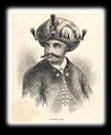Haider Ali
Haider Ali was born at Kolar near Bangalore in 1761 AD. He joined the army of Nawab of Arcot, but some years later joined the army of Mysore king. At that period of time Mysore state was surrounded in north by Marathas, in east by Nizam of Hyderabad and  in south by Nawab of Arcot and further down by English and also almost independent small rulers called Nayaks and Palegars. The state of Mysore was under the virtual control of a minister named Nanje Gowda as the king of Mysore was weak.
in south by Nawab of Arcot and further down by English and also almost independent small rulers called Nayaks and Palegars. The state of Mysore was under the virtual control of a minister named Nanje Gowda as the king of Mysore was weak.
Frequently the state of Mysore was with war against Marathas, Nizam of Hyderabad, and Nawab of Arcot or with Palegars. These was enabled the Haider Ali who was a military genius and brave warrior to rise in his military rank and become a military governor of Dindigul. Ultimately he replaced the minister Nanje Gowda to become the ruler of Mysore state. 1st Mysore War: From 1767 to 1782. It was war against English in which they were defeated. 2nd Mysore War: From 1782 to 1784. Haider Ali made an alliance with Nizam of Hyderabad and Marathas together fought with English traders, almost captured the Madras fort. This made English traders panicky and their army was reinforced from Bengal and Haider Ali was defeated and died.
Numismatic History: In 1761 AD Haider Ali took control of state of Mysore but the first coins were issued from 1763 from Nagar mint. His coins were only in Gold and Copper except for a Rupee. He continued the old tradition of Vijayanagar and Kaladi Kings, pattern of depicting Hindu Gods and Goddesses on his gold coins and Elephant on Copper coins on Reverse on Obverse of the coins initials "HE" in Persian.
 in south by Nawab of Arcot and further down by English and also almost independent small rulers called Nayaks and Palegars. The state of Mysore was under the virtual control of a minister named Nanje Gowda as the king of Mysore was weak.
in south by Nawab of Arcot and further down by English and also almost independent small rulers called Nayaks and Palegars. The state of Mysore was under the virtual control of a minister named Nanje Gowda as the king of Mysore was weak.Frequently the state of Mysore was with war against Marathas, Nizam of Hyderabad, and Nawab of Arcot or with Palegars. These was enabled the Haider Ali who was a military genius and brave warrior to rise in his military rank and become a military governor of Dindigul. Ultimately he replaced the minister Nanje Gowda to become the ruler of Mysore state. 1st Mysore War: From 1767 to 1782. It was war against English in which they were defeated. 2nd Mysore War: From 1782 to 1784. Haider Ali made an alliance with Nizam of Hyderabad and Marathas together fought with English traders, almost captured the Madras fort. This made English traders panicky and their army was reinforced from Bengal and Haider Ali was defeated and died.
Numismatic History: In 1761 AD Haider Ali took control of state of Mysore but the first coins were issued from 1763 from Nagar mint. His coins were only in Gold and Copper except for a Rupee. He continued the old tradition of Vijayanagar and Kaladi Kings, pattern of depicting Hindu Gods and Goddesses on his gold coins and Elephant on Copper coins on Reverse on Obverse of the coins initials "HE" in Persian.
Identification of Coins:
1. In early Indian coins the value and denomination were not minted (like in
modern coins) but these coins are identified by following.
2. By their metal content like Gold, Silver and Copper.
3. By depictions and legends on Obverse and Reverse.
4. By their weight and diameter of the coins.
5. By the mint name AH or AM year and Regnal year.
6. In Tipu Sultans Copper coins weather the Elephant is moving to left (after
AH1221) or To Right (up to AH1221).
7. Elephants trunk is raised or depressed similarly for the tail.
8. Other minor Identification points are Flag over the back Position of Front limb,
the word "Mohammad" is present or absent when present it is at
the beginning of the legend or at the end of the legend.
9. Lastly the coin is Grained (Milled) or not
modern coins) but these coins are identified by following.
2. By their metal content like Gold, Silver and Copper.
3. By depictions and legends on Obverse and Reverse.
4. By their weight and diameter of the coins.
5. By the mint name AH or AM year and Regnal year.
6. In Tipu Sultans Copper coins weather the Elephant is moving to left (after
AH1221) or To Right (up to AH1221).
7. Elephants trunk is raised or depressed similarly for the tail.
8. Other minor Identification points are Flag over the back Position of Front limb,
the word "Mohammad" is present or absent when present it is at
the beginning of the legend or at the end of the legend.
9. Lastly the coin is Grained (Milled) or not
